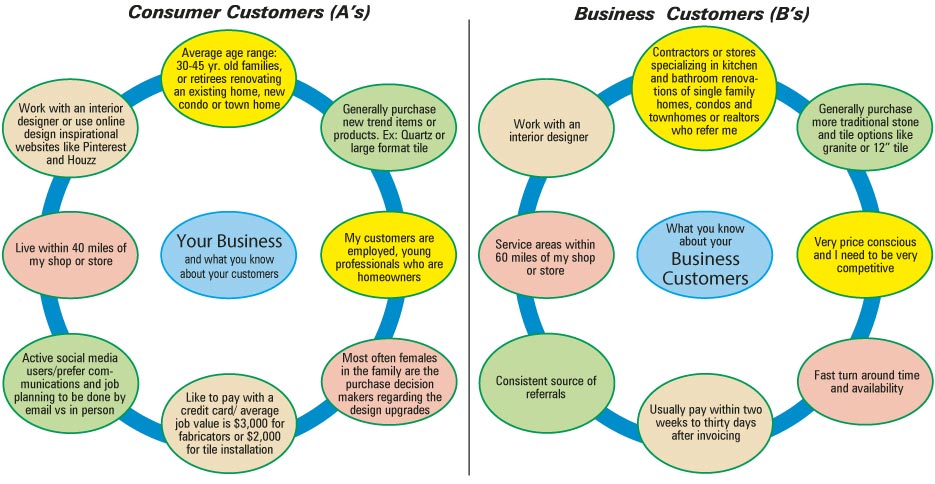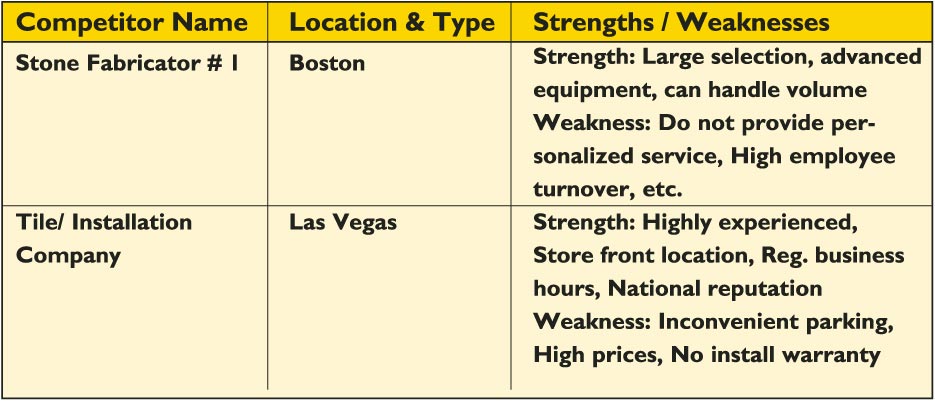What Can Your Customer Profile Tell You?
Michele Farry
Humblestone
In my previous SRG article, So You Think You Know Your Customer? (February 2017), I discussed the concept of decoding what we can learn about your clients, with this basic information broken down into three columns: How are people finding your business? What geographical areas you are reaching? What are some customer preferences where we can start to map out trends?
We are focusing on what we can learn from successful jobs and projects that were completed. In a future article we will look at what we can learn from missed opportunities. It is powerful to know when a project was not a good fit. The most difficult task can be to turn down work when most tile and stone companies are struggling to survive. However, walking away from a potential customer or project can save you money and prevent damaging your future profitability or reputation. One step at a time you are assembling a foundation for doing better business and informed decision making.
I would like you to look closely at the customer profile table, specifically at the details and information you complied. If you haven’t yet done this step, I encourage you to take a moment and complete it and come back to this article.
An excellent understanding of your market place begins with taking those broad fuzzy descriptions that are all mixed together, like age and income, and map them out more specifically. In this step I encourage you take the sheet of information you started and begin to separate the clients who are private customers (consumers) from (business/trade referrals). Let’s label the consumers A’s and the business clients B’s. Because the two customer types are not the same, we need to identify different things about them.
What do your (A) customer traits reveal that you hadn’t considered or noticed? For example, you may have realized your (A) customers tend to use the services of an interior designer or are often first-time homebuyers or young working families. Perhaps in your market you are completing more renovation projects versus new construction in your local area. Many businesses have to consider seasonal clientele and not consistent year-round new construction opportunities. On the contrary, you may have learned your bottom line with business customers is budget, quality standards or fast turn around time and offering generous availability.
Although the customer profile can be eye opening, maybe you did not know as much as you should when trying to put those facts on paper?
I hear regularly from entrepreneurs and tile and stone company owners that they are uncomfortable asking follow up questions. But having a few key questions or informal survey is okay, if not critical to doing good business. No one wants to rock the boat or open themselves up for criticism. Understandably this can be tricky, but should not be off the table for you. I challenge you to create a few standard questions relevant to your business.
What insights do you miss during the project and at completion? Knowing what to ask can separate you from inaccurate assumptions, so get the facts. Some sample questions are: How did you hear about us? What is the most important part of this project for you? For example, availability, price, convenience or selection may be an answer. Compared to other competitors you considered, how was our pricing the same or different? What was your decision ultimately based on to use our company? Is there anything I could have done differently that could have improved your experience with our business? After accomplishing even informal surveys you can take any of these answers and go back and plug them into your customer profile.
 |
Focusing on the private consumer client in graph (A) and the business client in graph (B) you can see what the table you made might look like. With these details you can seek target-advertising markets, align with similar contractors or designers for business growth.
Harnessing the customer profile and advancing to the next level will be step two. Are you providing the right products and services for your customers and how are you different from your competitors? Follow the instructions for the customer profile and let’s do a competitor profile.
 |
Make three columns again on a piece of paper. In the left hand column write down the name for as many competitors you can think of in your market. In the middle column put notes on their location, availability and if they are a storefront, etc. In the right hand column list their strengths and weakness to the best of your knowledge. In the next issue we will look at how to put this information together to develop a greater impact and excel in the tile and stone marketplace.
Michele Farry co-owns Humblestone and is passionate about entrepreneurship and small business growth. Michele has received awards for her work with profit-based and non-profit charity organizations.